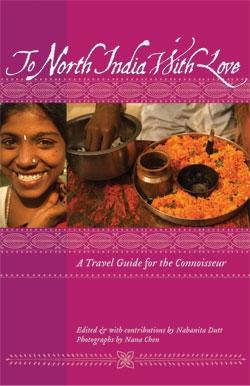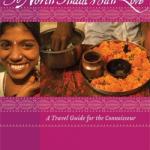Naomi Naam Encounters Delhi's King of All Kebabs
Excerpted from To North India With Love, available from ThingsAsian Press.
For weeks before I landed in Delhi, I had to put up with a bunch of foodie friends in London, who believed my impending India trip would be wasted without a proper education about the pros and cons of Indian food. Did I, for example, know that every Indian state had a different cuisine? Was I sufficiently knowledgeable about the many facets of Indian food to fully appreciate its diversity? Perhaps they should make it "easy peasy" for me by drawing up a list of good restaurants to eat at in Delhi.
Now this was ridiculous! Wasn't I a Brit as much as these guys? Knowing a thing or two about Indian food is in our genes. Even if my early experiences were predicated on entirely inauthentic vindaloos and Madras curries, I pride myself on being able to recognize the real thing.
So, I made up my mind. A "real thing" was exactly what I was going to track down in Delhi. Something traditional and truly authentic that none of these guys had even heard of. I would return from India only after having made this amazing culinary discovery. And I would be the toast of curry-loving London.
I arrived in Delhi armed with a long list of foodie contacts. On my first day in the city, I asked one of them if he could think of some dish that would have my friends back home regarding me with a new respect. My acquaintance had many suggestions. Cutlets made from animal brains. Whole lamb's testicle cooked in a creamy gravy. He also knew a restaurant that did amazing things with liver. This was interesting to me, but frankly, it was too obvious. There is nothing more awful than the Offal Bore-the sort of chap who brags about eating parts of the animal that most people throw away. I wanted a dish that was relatively common in India, but was virtually unknown in England.
Finally, my acquaintance came up with something. What about a kakori kebab?
I'd never heard of it.
"You'll see," he said mysteriously, and he bundled me into his car.
We drove for fifteen minutes through residential Delhi before arriving at an ordinary-looking restaurant where a large man was contemplating a charcoal grill. This man, said my new friend, would cook me an amazing dish that was truly worth bragging about.
The restaurant didn't have much by way of décor or ambience to recommend it. A few tables had been arranged around an open kitchen, and diners could watch their meats and breads being cooked in a huge clay oven called a tandoor. We grabbed a table by the window and ordered Thums Up, a popular local cola that probably did better business in India than Coke and Pepsi.
The kakori kebab arrived in due course, garnished with sliced onions and served with an herby green chutney. I confessed to a certain feeling of disappointment. "But this is just a sheekh kebab!" I complained.
"Try it," commanded my host.
I did.
He was right. Was he ever right!
It's difficult to explain the taste of a kakori kebab to someone who has never tried one. It is made of mincemeat and has the tubular shape of the sheekh. But the texture is completely different. When I took my first bite of kakori, the kebab melted on my tongue, and the flavor coated my whole mouth. There was none of that strong spiciness that people often associate with Indian cooking. I sensed delicate herbs lurking within the meat. My mouth was in thrall.
"Why have I never heard of this?" I asked, accusingly.
My host offered an interesting explanation. A kakori, he told me, is extremely difficult to make. It's a dish that is pretty much "owned" by the Qureshis, a family of celebrated chefs in India. A kakori chef is usually a member of the Qureshi family. Or at the very least, trained by one of them.
To make a kakori, the chef minces meat and fat, taken from the kidney region of the goat. The ratio of meat to fat is a secret that remains within the Qureshi family. After adding spices, the chef sets aside the kakori mixture for a few hours to tenderize the meat. Then, the mixture is pressed into a tube shape, threaded onto a skewer, and grilled over an open fire. The trick lies in getting the tubes firm enough to stay on the skewer. Lesser chefs get the ratio of mince to fat wrong. So when the fat starts to melt, their kakori simply breaks and falls off.
I ate four kakori kebabs that night. Two, the following night. Three, the night after that. Though I was told that a chef from the Qureshi family worked for the expensive Dum Pukht restaurant at the ITC Maurya hotel, I was quite satisfied with my unpretentious little hole-in-the-wall and its kakoris.
I kept an eye on the contemplative man working the grill, and when I finally got to explain the kakori-making process to my mesmerized audience of foodie friends in London, I mimicked his arm movements. A brief silence fell over the crowd as I finished describing the incredible sensation of biting into the silky-soft tubes he gently coaxed off the skewer.
"What was that name again?" asked one of my friends, his voice strained by an intense burst of lusty, gastronomic envy.
"Kakori," I said, and then added, smugly, "To make it easy peasy for yourselves, just call it the King of Kebabs."
FACT FILE:
New Delhi's best kakori
The kakori is a specialized dish, and you will not find it on the menu of most kebab restaurants in New Delhi. Aside from the city's many hole-in-the-wall venues, two of the best places to try it are Bukhara and Dum Pukht in the ITC Maurya hotel.
Diplomatic Enclave
Sadar Patel Marg
New Delhi
http://www.starwoodhotels.com/
 ThingsAsian
ThingsAsian

















